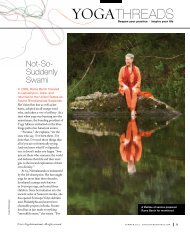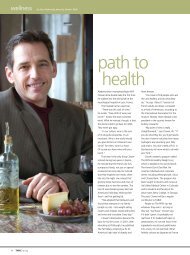No Yama, No Yoga - Anna Dubrovsky, Writer | Editor for Hire
No Yama, No Yoga - Anna Dubrovsky, Writer | Editor for Hire
No Yama, No Yoga - Anna Dubrovsky, Writer | Editor for Hire
- No tags were found...
You also want an ePaper? Increase the reach of your titles
YUMPU automatically turns print PDFs into web optimized ePapers that Google loves.
At 68, Dharma Mittracan still do most of the postures he modeled in 1984 <strong>for</strong> hisYOGA MASTER DharmaMittra in nirlamba shirshasana,in Cali<strong>for</strong>nia. The postures arepart of “divine purification,”he says. “They prepare one <strong>for</strong>seated meditation.”
<strong>No</strong> <strong>Yama</strong>, <strong>No</strong> <strong>Yoga</strong>famous poster. But he insists that “fancy poses” miss the point if students ignore yoga’s ethical rules.By anna dubrovskyDharma Mittra’s Master<strong>Yoga</strong> Chart of 908 Postureshas inspired students <strong>for</strong> almost 25 years. It hangs in homes and studios all overthe world. The poster doesn’t picture one of Dharma’s favorite postures: seatedin front of a computer. “I love computers,” Dharma says. “If I could, I wouldjust be in front of the computer all day, working with Photoshop.”Headstand: Juan Carlo, Ventura County Star / Corbis; Headshot: Courtesy of Ismrittee Devi & Dharma Mittra <strong>Yoga</strong> New York CenterThere was no Photoshop in 1984, whenDharma photographed himself in about 1,300postures. He cut the photos by hand, arrangedthem with pins, and affixed them with glue.<strong>No</strong>w the 68-year-old yogi is working on anupdated version of the poster, which remainsthe preeminent inventory of postures. He’sscanning the original photos and posing <strong>for</strong>new ones. It’s click and drag instead of pinsand glue. Dharma isn’t certain when the newposter—and a CD companion—will be availablebecause teaching duties keep drawing himaway from his computer.Dharma has joined the coterie of globe-trottingyoga headliners. As yoga bled from thefringe to the mainstream, practitioners discoveredthat the yogi in the famous poster isn’t along-dead Indian but rather a Brazilian-bornManhattanite who’s alive and kicking—into arm balances thatchallenge teachers half his age. In the past year he’s traveled toIsrael, Japan, and Germany, among other places. A Vanity Fairspread on “the world’s greatest yoga masters” featured Dharmain nirlamba shirshasana, a hands-free headstand, on a New YorkCity street. At an Omega Institute yoga conference with aWho’s Who list of faculty, Dharma took the stage on openingnight to lead chants and demonstrate his signature series ofpostures. It’s recognition that Dharma didn’t court, but he’susing it to spread his message.“I don’t encourage people to do fancy poses. They are notthat important,” he told <strong>Yoga</strong>+. “The goal of yoga is Self-realization:to find out who you are, why you’re here, who God is. GodDHARMA MITTRA Ahimsa vegetarian.Copyright ©2008 <strong>Yoga</strong> + Joyful Living. All rights reserved.and the Self are the same—exactly the same.”Such words from a man who’s mastered themost stunning of postures can be jarring <strong>for</strong> legionsof Westerners who equate complex asanawith yogic accomplishment. Even more jarringis Dharma’s prescription <strong>for</strong> “Self-realization,”which includes giving up meat, trusting in reincarnation,and making every action an offeringto God.Dharma uses the word “God” with the frequencyof a televangelist. It’s his way of remindingstudents that yoga isn’t gymnastics. Whereother teachers urge students to “rotate thethighs inward” or “engage the quadriceps,”Dharma offers this instruction <strong>for</strong> refining postures:“<strong>No</strong>w think of God.”Asana—the physical limb of yoga—is partof a process Dharma calls “divine purification.”The postures tone the body and prepare one <strong>for</strong> seated meditation.Dharma enjoins students to reflect daily on questions suchas these: Who am I? Why does everything die? Is anything eternal?Why do some people suffer? Why are some born into privilegeand others into poverty? Is there reincarnation? Is therekarma? When body and mind have been purified, the answerswill reveal themselves, he says.Breathing exercises and mantra recitation are also part of thepurification process, according to Dharma. So is study of ancienttexts, particularly the Bhagavad Gita, <strong>Yoga</strong> Sutra, and Hatha<strong>Yoga</strong> Pradipika. (“<strong>Yoga</strong> without these three is like spaghettiwithout the sauce,” he says.) Dharma is especially emphaticabout another building block: proper diet. He advocates a liveyogaplus.orgmarch - april 2008 yoga+joyful living 55
food vegetarian diet and occasional fasting.Stimulants, heavy foods, and foodsthat foster cravings inhibit deep concentration,he warns.Seasonal fruits and vegetables, nuts,and sprouts are staples of Dharma’s diet.He’s fond of avocados and fresh coconut.In the 1970s he enticed new students withflyers that promised free sprouts alongwith a free introductory lesson. “If you eatfried food, dead food, cooked food, youwill feel fried, dead, and cooked,” he says.Dharma eschews animal products save<strong>for</strong> an occasional bite of fresh mozzarella.He’s unequivocal about vegetarianism,citing the first yama, or ethical precept ofyoga: ahimsa. Often translated as “nonviolence,”ahimsa calls on us to treat allbeings with compassion. Dharma, whosedogs Pado and Pepper are also vegetarians,maintains that eating meat is participationin violence and that it puts spiritualbliss out of reach. He frequently quotesSwami Bua, a yogi who lives in midtownManhattan and is said to be 118 years old:“If you put animals in your stomach, youmake your stomach a graveyard.”Without adherence to the yamas andniyamas, the social and personal ethics laidout in the <strong>Yoga</strong> Sutra of Patanjali, “therewill be no success in meditation,” Dharmawarns. “If you don’t follow the ethicalrules, there’ll be no kingdom of God.”BRAD PITT WANNABE?At Omega’s <strong>No</strong>vember yoga conferencein Fort Lauderdale, Fla., more than 120students spread their mats under a whitetent <strong>for</strong> a class with Dharma. “He’s likethe Jack LaLanne of yoga,” one first-timerwhispered to another. A technician affixeda microphone to Dharma’s tunic and signaled<strong>for</strong> a sound check. “Om NamaShivaya,” Dharma chanted. “Om NamaShivaya.”Dharma’s physical prowess and selfdisciplineare intimidating only until hebegins talking. He’s as genial as he islimber. Senior disciples describe him asshy, but Dharma knows how to warm upa crowd. Within minutes of the openingchant, laughter rippled through the tent asDharma demonstrated how the less experiencedstudents could “pretend.” Anotherdemonstration inspired applause, promptingDharma to quip: “You can throwquarters.” The two-hour class included avigorous asana sequence, breathing exercises,deep relaxation, and discourses onvegetarianism, chakras, and reincarnation.It ended with a Dharma ritual that recallsthe break-dancing era. As kirtan kingKrishna Das blared through the speakers,bolder students took turns striking poses<strong>for</strong> the clapping crowd. It was a testamentto spirituality’s party side.If he had his way, Dharma says, hewould reincarnate as the pope or acelebrity. As the head of the CatholicChurch or a Brad Pitt–style star, hecould speak to millions instead of hundreds.He could urge people “to becomevegetarian, to keep the ethical rules, tosurrender to the Lord, to not be attachedto happiness from material things.”Pope would be a far cry from horsethief. Dharma has owned more than adozen bicycles, and one by one they’vebeen stolen. His hunch is that’s because hewas a horse-napper in a past life. “Everythingis due to deeds from previous lives,”he says. “It’s like paying your bills.”These days, Dharma commutes from hishome to his yoga center, several blocksaway, on a Segway scooter. He’s learnedhow to negotiate icy patches after a fewfalls. It’s his second Segway; the first wasstolen.Faith in reincarnation and karma isessential to spiritual bliss, Dharma says.People who don’t believe in reincarnationfear accidents, old age, and death. Peoplewho don’t understand the laws of karmablame others or God <strong>for</strong> their problems.“If you don’t understand the laws ofkarma, you are restless all the time,”Dharma says. “If you realize karma, youbecome fearless, content. Only a contentmind can meditate.DHARMA WITH HIS FAMOUS POSTER For its 25th anniversary, he is working on an updated version.<strong>Anna</strong> <strong>Dubrovsky</strong>, who is based in Pittsburgh, is acontributing editor of <strong>Yoga</strong> + Joyful Living.56 yoga+joyful living march - april 2008 yogaplus.org
DAY TO DAY IN NEW YORK (From left) Dharma teaching a class; meditating; on his Segway scooter, which he uses to commute between studio and home.Courtesy of Ismrittee Devi & Dharma Mittra <strong>Yoga</strong> New York Center“I have many yoga teacher friends whoare getting old now. Some come to mevery depressed,” he says. They don’t lookthe way they used to, and they struggle inpostures that once came easily. Their childrenare grown. Adoring students andspouses are gone. “I keep telling them:‘Realize reincarnation! Get busy into Selfrealization,Self-knowledge. Because youare not this that’s passing away.’”THE GROUNDBREAKING POSTERA few months ago, Dharma looked in themirror and decided that his shouldersneeded some work. He headed to thegym. “Sometimes I like to target specificmuscles with modern gym equipment,” heexplains. Dharma knows a thing or twoabout building muscle. As a teenager inMinas Gerais, Brazil, he took up bodybuilding,wrestling, and Brazilian jiujitsu.In the early 1960s, while serving in theBrazilian Air Force, Dharma captured theMr. Minas Gerais title and opened a bodybuildingschool in that state’s capital.But his most recent trip to the gymdid not go smoothly. “I ended up hurtingmy shoulder badly,” says Dharma. Hismuscles are less resilient than they usedto be. And his interest in the physicalpractices of yoga has dwindled. But hisclasses are no less rigorous than theywere four decades ago. In fact, he’s madethem harder to satisfy new generations ofpractitioners. “He adjusts things accordingto the people, to make people feelgood,” says Ismrittee Devi Om, who hasstudied with Dharma since 1984 and isco-director of Dharma Mittra <strong>Yoga</strong>. “Hedidn’t need to change a thing, but he’smoving it <strong>for</strong>ward. Years ago it was thehardest class in Manhattan, but now it’sreally hard. I have to tell people. Theythink Dharma is old-fashioned, quietyoga, but it’s not.”While waiting <strong>for</strong> his shoulder to heal,Dharma has taken to practicing postureslike urdhva dhanurasana (upward bow)and vrishchikasana (scorpion) with onearm. “I have to be able to do the posesbecause when you do it, it is easier toteach,” he says. “But other than <strong>for</strong> teaching,I don’t waste too much of my timedoing fancy poses anymore. I don’t seeany need.”He estimates he can still do about 80percent of the poses in his groundbreakingposter. For the updated version, he’llreplace about 20 with more popular variations.“There’s something mesmerizingabout that poster. People are drawn toit,” says Chandra Om, Dharma’s seniordisciple and founder of the <strong>No</strong>rth CarolinaSchool of <strong>Yoga</strong>. “A little-known factis the head-space that Dharma insisted hebe in <strong>for</strong> 1,300 photographs. If his mindwas not fully concentrated on God, hewould redo the posture. He would neveruse any photos where his mind was distracted<strong>for</strong> even one moment. That is theDharma’s physical prowess and self-discipline are intimidating only until he begins talking. He’s asgenial as he is limber. Senior disciples describe him as shy, but Dharma knows how to warm up a crowd.real practice of the postures. The posturesmean absolutely nothing, no matterhow adept one is at them, if they’re notdone in a spirit of devotion.”Dharma dedicated the poster to hisguru, Swami Kailashananda, also knownas Yogi Gupta. Dharma lived at his guru’sNew York City ashram <strong>for</strong> about adecade after arriving in the United Statesin 1964, practicing karma yoga, the pathof selfless service. He cooked his guru’smeals and shaved his head, taught yogaclasses to other disciples, and served asashram handyman.The mistake so many yoga studentsmake is expecting benefits from yogapractices, Dharma says. “That is the naturaltendency. People are always expecting:If you do the meditation, you’reexpecting to have some results. Even inyour prayers, you’re always asking, asking,asking.” Expectations frequently giverise to disappointment. When selfishnessis stripped from the practice, when egorecedes, the benefits will come, he says.“Keep the ethical rules, eat the rightfood, surrender to the Lord, and loseyour ego. That’s all. You don’t have toput your legs behind your head, do allthese fancy poses.“But if you enjoy all this jumping,”he says with a chuckle, “go ahead.”+For more in<strong>for</strong>mation about DharmaMittra, visit: www.dharmayogacenter.com.yogaplus.org march - april 2008 yoga+joyful living 57









